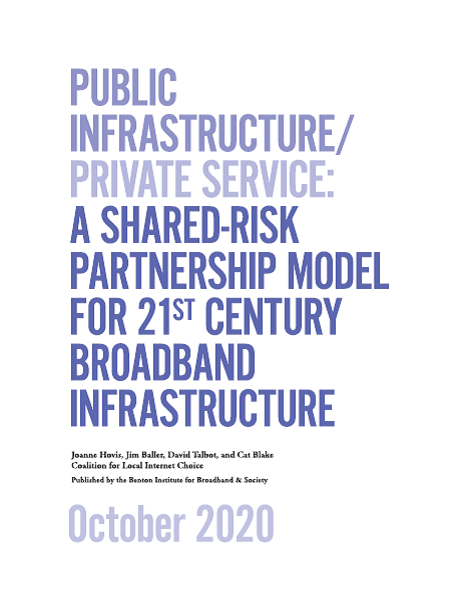Legal Issues in Broadband Public-Private Partnerships: Finding a Private Partner
Monday, October 19, 2020
Digital Beat
Legal Issues in Broadband Public-Private Partnerships: Finding a Private Partner
A growing number of local governments are coming to see fiber broadband networks as essential infrastructure for the 21st century, infrastructure that is capable of driving and supporting simultaneous progress in just about every area of significance to their communities. This includes economic development, education, health care, environmental protection, energy, transportation, government services, digital equity, and much more. While such benefits may be difficult to measure in monetary terms—as is also true of the monetary benefits of roads, sidewalks, electricity, sewers, and water—they are real nonetheless. For many communities, these benefits are likely to be the primary reasons for entering into a public-private partnership.
Several major legal issues may arise in a broadband public-private partnership project, including confirmation of authority, pre-negotiation project planning and finding potential private partners, and negotiation of the agreement.
Early in a typical fiber project, a group of local champions emerges and launches an exploratory process to determine whether and how the community can obtain an advanced communications system. The champions often include local government officials, business leaders, educators, health care professionals, young people, and a wide range of others. These champions tend to be individuals with lots of positive energy and an ability to inspire and encourage others to follow their lead.
At first, the champions commonly invest many hours obtaining high-level information about fiber broadband initiatives, particularly from individuals who have participated in such projects in comparable communities and are eager to share their experiences. Eventually, the process will reach the point at which more specific information is necessary to understand the community’s unique combination of broadband goals, assets, needs, opportunities, challenges, and potential partners.
At this point, many local governments have found it useful to solicit input through a “Request for Information,” a “Request for Qualifications,” or a similar process (collectively “RfX” processes) that are not constrained by formal procurement requirements.
A good RfX process can be beneficial on multiple levels. First, the process of designing the RfX requires the community’s leaders to form and build consensus around imaginative new visions of the community’s potential. Second, the RfX allows the community to market these visions, not just to prospective partners but also to the community’s businesses, institutions, and residents. Third, the process allows for extensive informal communications between the local government and potential partners, who often compete with each other to win the local government’s support. These communications might not only help the local government test the validity of its going-in assumptions but might also open its mind to even better ideas.
By the end of the RfX process, a local government should have a well-refined understanding of what it wants to do; what it realistically can get and must give in return; what the approximate costs, revenues, and other benefits and burdens will be; and with whom it would like to partner. With this knowledge, the local government can issue a formal Request for Proposals or engage in whatever other procurement process applicable state and local law require it to follow.
Once the local government has developed its short list of the potential partners, negotiations to finalize the agreement can commence. Depending on state and local procurement requirements and the local government’s preferences, the negotiations may proceed with one bidder at a time or with multiple bidders simultaneously. Either way, the local government’s objective will be to achieve the best possible allocation of risks, responsibilities, and rewards for the community.
Although positive network externalities are difficult to measure precisely, a growing body of literature is emerging on useful ways to estimate them. For example, Dr. Bento Lobo, an economist at the University of Tennessee, has estimated that the municipal fiber utility in Chattanooga, Tennessee, produced more than $1.3 billion in economic and social benefits in its first five years and is likely to produce even greater benefit in the years ahead.[1]
For more on the legal issues that arise in broadband public-private partnership project, see Public Infrastructure/Private Service: A Shared-Risk Partnership Model for 21st Century Broadband Infrastructure.
Jim Baller is president of Baller Stokes & Lide, PC, a national law firm based in Washington, D.C. He represents clients in a broad range of communications matters nationally and in more than 35 states. Baller is president of the Coalition for Local Internet Choice, which represents a wide range of public and private interests that support the authority of local communities to make the broadband Internet choices that are essential for economic competitiveness, democratic discourse, and quality of life in the 21st century. He was the founder and president of the US Broadband Coalition, a consortium of more than 160 organizations of all kinds that forged a national consensus on the need for a comprehensive national broadband strategy and recommended the framework reflected in the Federal Communications Commission’s National Broadband Plan. The Fiber to the Home Council has recognized Jim as “the nation’s most experienced and knowledgeable attorney on public broadband matters.”
Notes
[1] David Flessner, “2020 Trend: Gig City’s second decade will deliver more speed, innovation,” Edge, https://tinyurl.com/y6kq2lx5 (Dec. 31, 2019; See also Fiber Broadband Association, “Economic Impact: Fiber Speeds = Improved Economic Importance,” https://tinyurl.com/y363u7s3; National Telecommunications and Information Administration, “Measuring the Economic Impact of Broadband, https://tinyurl.com/y457b597 (Sept. 18, 2019); Institute for Local Self Reliance, “Municipal Networks and Economic Development,” https://tinyurl.com/y2kamgll.
The Benton Institute for Broadband & Society is a non-profit organization dedicated to ensuring that all people in the U.S. have access to competitive, High-Performance Broadband regardless of where they live or who they are. We believe communication policy - rooted in the values of access, equity, and diversity - has the power to deliver new opportunities and strengthen communities.
© Benton Institute for Broadband & Society 2020. Redistribution of this email publication - both internally and externally - is encouraged if it includes this copyright statement.
For subscribe/unsubscribe info, please email headlinesATbentonDOTorg







